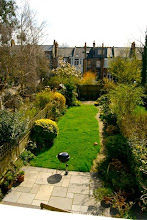

Great Expectations -- a book that demands to be re-read at the beginning of any New Year -- is my favourite of all Dickens' novels, and Miss Havisham survives (for me, as for legions of other readers) as one of the most remarkably potent literary creations; the quintessential gothic bride, the eeriest woman in white, who has haunted my own writing and dreams since the first time I discovered Great Expectations as a child. So it was always going to be difficult to watch the BBC's new adaptation without some feeling of disappointment at what, inevitably, had to be left out. And yes, I missed the scene in which Magwitch rises up from the graves of Pip's family, and the kindly Biddy (although perhaps she will appear in the second episode tonight?); but thus far, it has been brilliantly executed. Gillian Anderson is inspired as Miss Havisham, and the landscape of the muddy marshes is as powerfully evocative as the shadowy Satis House and its abandoned wedding feast, still untouched, even as it decays and turns to dust.
All of which reminds me of the threads between several other women in white that intrigued and perplexed me while I was writing 'My Mother's Wedding Dress'; from the Brontës to Emily Dickinson, Hans Christian Andersen's Snow Queen to the White Witch of Narnia; and in Daphne du Maurier, of course. (For more on the role of the Snow Queen in Daphne, and the uncanny connection between Du Maurier and De Winter, read here). It was my mother -- a courageous radical who chose to be married in black -- that introduced me to Emily Dickinson’s poetry when I was nine or ten, around about the same time that I was having nightmares of a porcelain woman in white who fell down a gothic staircase, and lay smashed at the bottom; not that the two were necessarily connected, but when I remember them – the book and the dream – they seem to reflect each other. Oddly, although I now find Dickinson's meaning increasingly elusive (in a wonderfully tantalizing way), as a child, the effort to understand was less. The anthology my mother gave me was for children (its unforgettable title taken from the poem I’m Nobody! Who are you?); and also contained biographical details, including a brief account of Dickinson’s life within her father’s house in Amherst, Massachusetts: a woman who wore only white dresses, unseen and hidden behind closed doors or in the shadows. I’d been told that one of her white dresses remains in her father’s house, now a museum; though it seemed to me by the time I was a teenager that Dickinson had turned her room into a kind of museum when she was still alive, shutting herself away in it to write her poetry; not that she had planned to make an exhibition of herself, but nevertheless, I wondered whether she realized that interest in her would intensify after her decision to withdraw from view.
When my mother gave me the anthology, however, I was too young to think about what prompted Dickinson to become a white-clad recluse. (And I hadn’t yet read Ted Hughes’ description of her, in the introduction to his selection of her poetry: ‘she wore white, proper for a bride of the spirit, and she daily composed poems that read like devotions’). I was more interested in the poem that gave the title to my book, and also the one that began, ‘I started Early – Took my Dog – / And visited the Sea – / The Mermaids in the Basement / Came out to look at me – ’. I imagined Emily in her white dress, creeping out of her father’s house at dawn, her dog by her side, when no one else could see her; and walking to the seaside, to find the mermaids, with their long pale hair, and beckoning hands. And the water was lapping around her feet, and higher (‘ – till the Tide / Went past my simple Shoe – / And past my Apron – and my Belt / And past my Bodice – too – ’); so that she was up to her neck, her hair floating in the water like the mermaids’.
I don’t remember reading her more opaque poetry at the time; it was only later that it got under my skin (her impenetrability finding its way into me, yet remaining intact). But whenever I read it now, there are still lines that I recognize as if from childhood; for I have never studied Dickinson in a formal sense, tending to avoid critical dissection of her work (which may mean, of course, that my response to her is simply childish; though I am also inclined to agree with Thomas Wentworth Higginson, who wrote in the Atlantic Monthly, twenty years after meeting Dickinson, that her enshrouding was too complete to undo: ‘She was much too enigmatical a being for me to solve in an hour’s interview . . . I could only sit still and watch, as one does in the woods; I must name my bird without a gun, as recommended by Emerson’).
Sometimes I feel irritated with myself, with my failure to make sense of her work; but I also like the fact that it remains out of reach, not analysed, not unfolded. And when I don’t understand the poems, there are things – white dresses, named and made manifest – within them that can be recognized with the clarity of an often-repeated dream. So that now, when I read the poem that begins: ‘Because I could not stop for Death – / He kindly stopped for me’ (lines that I remember as well as a nursery rhyme), I cannot help but see the translucent figure that emerges between the lines: ‘For only Gossamer, my Gown – / My Tippet – only Tulle – ’.
It was, perhaps, inevitable that I would progress from the Brontës and Emily Dickinson to an equally mythic Sylvia, who describes herself in ‘Tulips’ in hospital, on her sickbed; a patient, seeking the patience of a nun, colourless, day-clothes gone. (‘Look how white everything is . . .’) ‘I am nobody,’ says Plath in the same poem, echoing Emily Dickinson; and speaks of learning peacefulness. But as I kept on reading more of her poetry (as one does, in gloomy adolescence), she didn’t seem very peaceful to me, unless you accepted that death bestowed peace (not that she did rest in peace); and the whiteness in her poems was as likely to signify bleached bones and death (though I was touched, not long ago, to see a less tortured picture of Plath, wearing white, with her children and spring flowers, and to read her daughter's own words).
Thus poetry was an antidote to cult of happy-ever-after brides; for the more I looked (or rather, read), the more it seemed that women in white were inverted angels, mad, bad and dangerous to know; from the suicidal Anne Sexton, whose reworking of Snow White I had discovered amongst my mother’s books of poetry, alongside Sylvia Plath, all the way back to Miss Havisham, who looms over Great Expectations like a risen corpse. (At first, when Pip makes her out in the gloom of her darkened, shuttered room, he believes her to be an entirely white figure: dress, shoes, veil, even her hair. But as his eyes grow accustomed to the shadows, ‘I saw that everything within my view which ought to be white, had been white long ago, and had lost its lustre, and was faded and yellow. I saw that the bride within the bridal dress had withered like the dress, and like the flowers, and had no brightness left but the brightness of her sunken eyes. I saw that the dress had been put upon the rounded figure of a young woman, and that the figure upon which it now hung loose, had shrunk to skin and bone.’)
Two decades after the publication of Great Expectations, Emily Dickinson was directly compared to Miss Havisham by Mabel Todd, the family friend who later undertook the editing of Dickinson’s poetry; she noted in her journal of 1882 that ‘Emily is called in Amherst “the myth”. She has not been out of the house for fifteen years. One inevitably thinks of Miss Haversham [sic] in speaking of her . . . She wears always white, & has her hair arranged as was the fashion fifteen years ago, when she went into retirement.’)
At some point in that periodically gloomy, typically tempestuous adolescence (such a relief to be mostly beyond its reach, into the calmer waters of middle age; although I remain grateful for the reading I undertook at the time, which was perhaps the making of me), I discovered that Sylvia Plath and Ted Hughes had gone to Haworth together, weaving poetry out of their walks through the graveyard beside the Brontë parsonage and up onto the moors of Wuthering Heights. And I knew, too, that Emily Dickinson was an admirer of Emily Brontë, whose poetry had been read at her funeral, and that Plath and Hughes were fans of both Emilys, and that you could draw threads between all four poets (and Dickens and Wilkie Collins, as well); white threads, of course.
All of which reminds me to broadcast the appeal from the church in Haworth where Charlotte and Emily Brontë are buried. Their white shrouds are almost certainly turned to dust, but their words are vibrantly alive, which is miraculous, is it not?
Speaking of miracles, I am very happy to announce that my thoughts are turning to a summer wedding dress, preferably not of the tattered design favoured by Miss Havisham; for an interest in gothic narrative has failed to obliterate my belief in the continuing possibilities of happiness and contentment, and the undeniable magic of the greatest expectations of all.

















